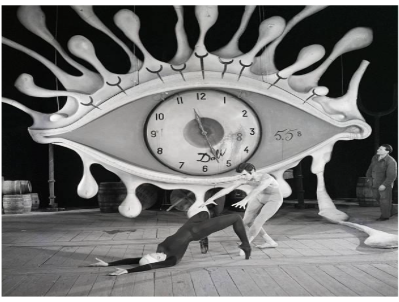DADA ART MOVEMENT
Surrealism is an artistic and literary movement that emerged in the late 1910s and gained significant traction in the early 1920s. Originating from the Dada movement, which emerged as one of the most revolutionary art movements, Surrealism emerged as an anti-establishment art movement. It was developed when numerous artists and intellectuals, who opposed the Great War, sought refuge in Zurich. As the war persisted, their art became highly experimental and anarchic. Artists and writers held the belief that war was futile and abhorrent. During the Dada movement, art mocked materialistic and nationalist attitudes. Dada artists utilised everyday objects that could be presented as art with minimal manipulation. They rejected traditional art and embraced illogical and absurd elements. Following the war, Dadaism began to decline, and several artists and writers sought alternative means of expression.
ORIGIN OF SURREALISM
Surrealism emerged as a cultural and artistic movement, profoundly influenced by Dadaism. Originating in Europe as a reaction to the devastating consequences of World War I, Surrealism sought to confront the brutality and horrors inflicted upon humanity.
André Breton, a poet and critic, formally consecrated Surrealism in 1924 through the publication of “The Surrealist Manifesto.” This foundational text advocated for the liberation of the human mind from rational thought and societal constraints, emphasising the positive expression of art. Surrealist artists believed that juxtaposing elements from the conscious and unconscious realms of experience, dreams, and irrationality could create a realm distinct from reality.
Surrealist works often employ elements of surprise, non sequiturs, dreamlike imagery and unanticipated juxtapositions. Theories of Sigmund Freud, an Austrian neurologist and the founder of Psychoanalysis, profoundly influenced Surrealism and its concepts. Freud’s psychoanalytic theory of the unconscious mind held significant importance for Surrealists, as they believed that accessing the unconscious mind was the key to creating exceptional art. Freud’s theory posited that the unconscious mind holds a repository of memories, thoughts, and desires that remain beyond our conscious awareness.
Freud believed that these unconscious elements influence our behaviour and thought process in ways we might not completely understand. Freud also developed the theory of “free association”, a technique used in Psychoanalysis where patients are encouraged to share their thoughts without censoring them that allows their hidden memories and feelings to surface. Surrealists were fascinated and influenced by Freud’s theories of the human psyche and used his ideas to liberate their imagination and create art that was free from the constraints of rational thought.
TECHNIQUES OF SURREALISM
The surrealist movement was dedicated to exploring the subconscious mind and creating mind-bending artistic works. They developed several innovative techniques, including frottage and grattage. Frottage involves rubbing graphite over wood or other textured surfaces, while grattage entails scraping the canvas.
Max Ernst, a highly skilled painter, was an ardent admirer of these techniques. He envisioned creating partial images that individuals could fill in their own minds.
Ernst also devised the technique of Oscillation. Inspired by physics, mathematics, and astronomy, he endeavoured to integrate these disciplines into his art. He was particularly captivated by the unpredictable nature of a compound pendulum, a body composed of two or more masses connected and capable of swinging back and forth. Ernst was drawn to the concept that an artist could never exert complete control over the process.
To create Oscillation, Ernst would allow paint to drip from a tin perforated with holes. He would attach the tin to a long string and swing it back and forth over the canvas. While the process was messy, it yielded an incredibly gratifying outcome.
One of the most significant and captivating techniques introduced by Surrealist artists was Automatism. It served as a central principle within the Surrealist movement, facilitating the bypass of the conscious mind and the access to the subconscious. Automatism was underpinned by Freudian Psychoanalytic theory, which explored the depths of unfiltered desires and impulses inherent in humans. Artists relinquished conscious control, allowing their hands to move spontaneously on the page. This resulted in the creation of abstract, chaotic, and biomorphic forms that were subsequently transformed into more intricate paintings by the artist.
Invented by French engraver Simon François Ravenet and subsequently popularised by Spanish artist Óscar Domínguez, Decalcomania was a transfer technique that involved spreading paint onto a surface, such as glass, and then pressing it onto another surface, like a canvas or paper, to create an image through chance. This method enabled artists to generate spontaneous and unexpected patterns, which were further enhanced by the artists aligning with the surrealist objective of evading the conscious mind.
Several renowned artists contributed to the Surrealist movement, including Salvador Dali, René Magritte, Joan Miró, Max Ernst, Yves Tanguy, and André Masson. The Surrealist Art Movement revolutionised the art world by tapping into the subconscious mind and challenging rational and logical thought processes to unlock creative potential. Surrealists believed that through their art, they could attain greater personal and social freedom by questioning the nature of reality and societal norms, thereby blurring the boundaries between dreams and reality. Surrealism provided artists with a powerful platform to develop innovative techniques, explore their experiences, and achieve exceptional creative expression.
The legacy of Surrealism continues to resonate in contemporary art, film, and fashion. Artists continue to explore the subconscious, dreams, human desires, and irrationality, utilising their art to critique contemporary issues.


Leave a Comment